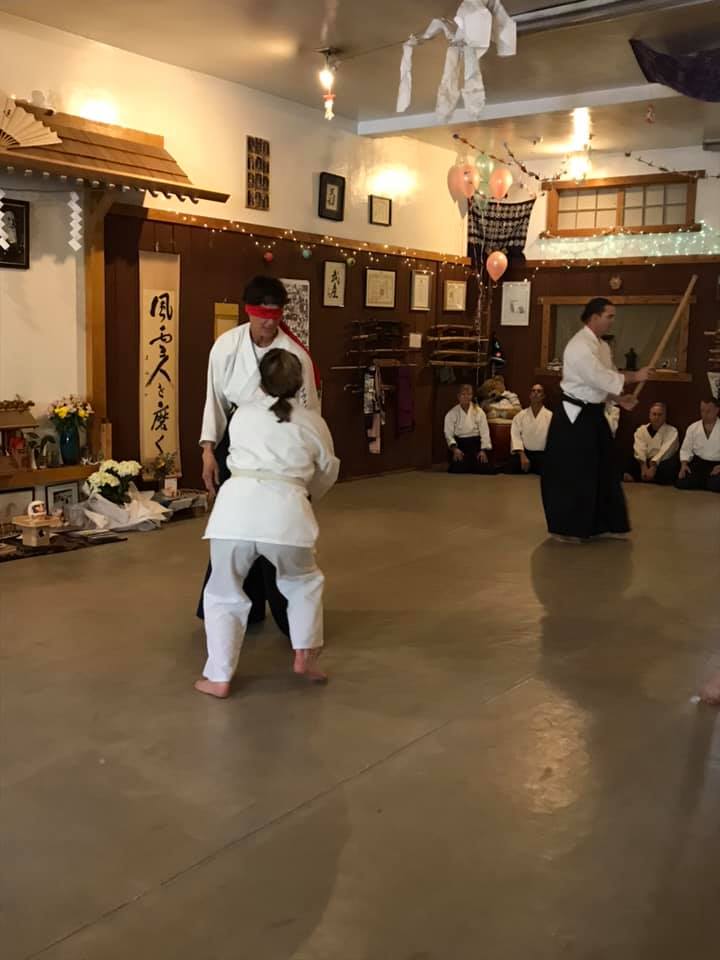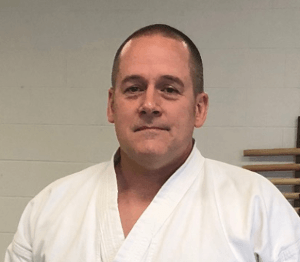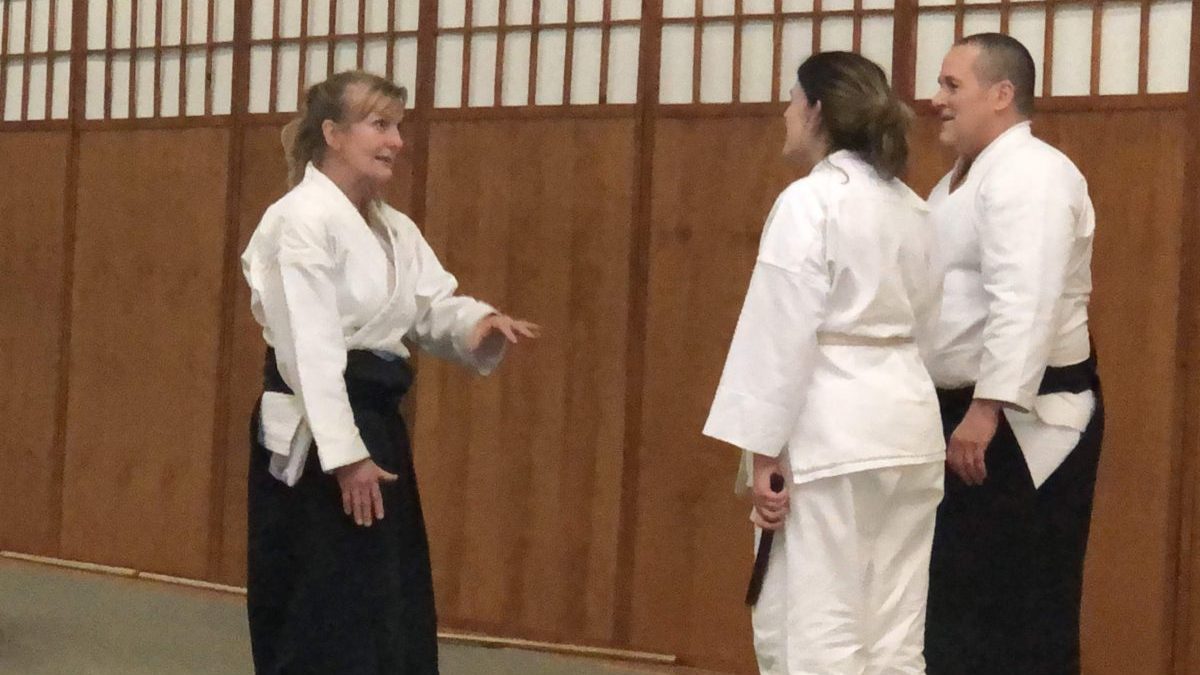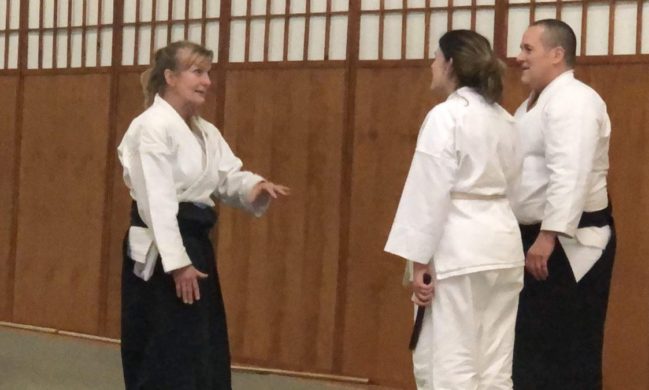
Introduction
I’m often asked about about our dojo’s lineage by both new students and visitors. I believe this is a timely topic. This post discusses both the concept of “lineage” and provides some background on the importance of a clear and active lineage.
Lineage? Why is it Important?
This post isn’t intended to be a criticism of any specific dojo or organization. If you’re currently studying Aikido, and you’re happy with where you are, then you’re in a good place. This is especially true if you’re being honest with yourself, and your training goals are well defined. However, not everyone has found their ideal dojo. For the dedicated Aikido student, defining your own practice and choosing a dojo to support your practice goals is a serious life choice. I’ve been lucky to have always been a member of a dojo with both a well-defined lineage and a clearly defined mission. We believe that a dojo’s lineage is very important, and that an active connection to that lineage supports the development of good, solid Aikido.
These days, there is a good deal of online chatter about the “effectiveness” of Aikido. Arguments about Aikido’s effectiveness are often made by people with little martial arts experience. Even so… it’s both dangerous and irresponsible to simply discard these arguments without honest consideration and introspection. One of the broader, and sometimes valid, arguments is that Aikido has become “diluted” over the last few decades and that its “effectiveness”, as a martial art, has been reduced as a result. Our dojo works to address some of the more valid arguments in our daily practice.
What is Lineage?
What does the word “lineage” mean in the context of a martial art? The term refers to a well established line of “transmission”. The word “lineage” implies a LINEAL heritage — one line directly progressing from the founder of the art. Lineage is sometimes argued as being more relevant when discussing Koryu arts (e.g. “traditional school” or “old” arts). However, lineage is important for Gendai, or modern arts, as well. Aikido, considered Gendai Budo, is no exception. There are several important reasons why lineage is important, the following sections discuss these reasons.
An Uninterrupted Line of Transmission
The first aspect of lineage is the concept of an uninterrupted line of transmission between student and teacher. Where Aikido is concerned, there is no argument that the founder, O-Sensei Morihei Ueshiba, is the sole creator of Aikido. O-Sensei’s lineage is well documented. The lineage of all of O-Sensei’s principal disciples, thanks to the efforts of people like Stanley Pranin, is also well established. Aikido Journal has documented O-Sensei’s major students here. The disciples on this chart are well established as the people initially responsible for the global dissemination of the Art of Aikido. These disciples represent, in most cases, the 2nd generation of Aikido teachers. This is where most dojos find the roots of their lineage.
Social Importance of Lineage
An important aspect of lineage is the “social” aspect. Long-term dedicated study with a teacher that provides a clear lineage, that starts with O-Sensei and ends with your home dojo, helps students understand where their Aikido originated. A direct and on-going student/teacher relationship, in both Koryu and Gendai Budo, might be one of the most relevant aspects of any Aikido dojo that considers itself “traditional”. A student studying at a dojo with a well-defined lineage is a part of an extended family.
Upstream Relationships
A well-established relationship says something about both the student and the teacher. The student recognizes both the sacrifices and investment that the teacher has made. The student owes a debt to his/her teacher. The dedicated student owes the same debt to everyone in their lineage, all the way back to the founder of the parent art. Aikido is no exception. The teacher, in turn, trusts the student with the knowledge he/she is transmitting. This is, of course, a simplified view of the importance of a direct student/teacher relationship. As a member of a dojo, your Sensei’s student/teacher relationship, is very important both to the dojo and to you personally. A close relationship with a qualified teacher helps insure continuity of the art, and instructional robustness.
Enhanced Training Opportunities
Lineage also serves as a kind of “passport”. If you’ve studied with a well-known teacher, you’ll find that significant training opportunities will sometimes arise as a result of this relationship. The dojo and its students exist as a member of an extended Aikido family. Training opportunities like long-term/uchideshi study are also far more accessible.
Our Dojo’s Lineage
Our lineage starts with Morihei Ueshiba O-Sensei, the founder of Aikido. Following O-Sensei is Morihiro Saito Shihan, who studied under O-Sensei for over 23 years. Our Division Head is Patricia Hendricks Shihan who was a long-term student of Morihiro Saito Shihan. Hendricks Sensei spent more than 7 years as uchideshi at the Founder’s dojo in Iwama. Our long term teacher, Yvonne Thelwell, is a student of Patricia Hendricks Shihan. Thelwell Sensei also studied under Donny Lyon Sensei (deceased), who studied directly under Morihiro Saito Shihan, and she spent time as an uchideshi at the Founder’s dojo in Iwama. See our dojo’s detailed lineage.

The Start of My Aikido Career
My personal Aikido career started in 1995 at Northern Virginia Ki-Aikido. NoVA Ki-Aikido is one of the longest-standing Aikido dojos in the Northern Virginia/DC area. My first Aikido teacher, George Simcox (6th Dan – Dojo-cho – dec. Nov 2000), was a student of Koichi Tohei. I was fortunate to be able to attend classes at my first dojo nearly every day! I learned a good deal from my teachers and sempai at this dojo, and I still visit them annually.

Iwama-Style Aikido
In early 2001, I moved from Falls Church, Virginia to Arlington, VA. I found that I’d purchased a home within walking distance of three fantastic Aikido dojos. I chose to study Iwama Style Aikido at Aikido of Arlington. I’ve been a student of Yvonne Thelwell Sensei (6th Dan – Dojo-cho) for the last 18 years. I was lucky to have found a dojo that held classes almost every day. Aikido of Arlington also had a well established Yudansha population, all of whom had very strong Aikido. My Shodan and Nidan tests were officiated by both Patricia Hendricks Shihan (7th Dan – Dojo-cho – Aikido of San Leandro) and Thelwell Sensei. I’ve also been very fortunate to have had the opportunity to study under Mark Larson Sensei (6th Dan – The last American uchideshi to Morihiro Saito Shihan). I also credit many others (teachers and sempai), far too numerous to list with providing amazing training opportunities.
Our Teachers
Thelwell Sensei’s first teacher, Donny Lyon Sensei, studied directly with Morihiro Saito Shihan, as did Thelwell Sensei. Our Colorado Springs dojo continues to take technical direction from Thelwell Sensei. As a member dojo of CAA Division 1, we also take technical direction from our Division Head, Patricia Hendricks Shihan. Hendricks Shihan holds the rank of 7th Dan (Aikikai). Hendricks Sensei was awarded the title of Shihan (“Teacher of Teachers”) in 2014 by Doshu Moriteru Ueshiba. Morihiro Saito Shihan also granted her the first Aiki-Ken/Aiki-Jo Menkyo Kaiden, or Teaching License, in 1988. She spent more than 7 years living in Japan studying as uchideshi to Morihiro Saito Shihan.
Morihiro Saito Shihan
Morihiro Saito Shihan spent 56 years of his life practicing Aikido. He first met Morihei Ueshiba O-Sensei in 1946 at the age of 18. Saito Sensei trained directly under O-Sensei for 23 years (1946-1969), until O-Sensei’s passing. During his time studying with O-Sensei, Saito Sensei’s schedule and his close proximity to the Iwama Dojo allowed him to study as an uchideshi, or live-in student. Saito Sensei was appointed guardian of the Aiki-shrine and Dojo-cho of the Iwama dojo by O-Sensei. Saito Sensei served in this capacity until his passing in 2002.
When I started Aikido, like all new students, I didn’t really understand the importance of lineage. I have been lucky to have had both training opportunities, and amazing teachers. My teachers have always recognized the importance of lineage and worked hard to maintain it as part of a traditional approach to teaching Aikido.
How Important is Lineage?
Speaking as someone with over 20 years of experience studying Aikido, lineage is important. Aikido is a Japanese martial art, and as noted earlier, it’s a good example of Gendai Budo. Transmission of any art is best accomplished through direct and diligent training.
You can’t learn Aikido from YouTube videos. It’s not possible to learn the Art of Aikido by reading books. You can’t learn Aikido by talking about Aikido. Aikido can’t be learned by attending an occasional seminar, nor does attending a seminar include that teacher in your lineage. There are many technical nuances that are only really absorbed by long-term study under the guidance of a qualified teacher. Lineage helps provide both instructional continuity and support. Lineage also helps students understand how and where they fit into the greater Aikido community.
How Can a Dojo’s Lineage be Determined?
It’s difficult for a dojo to exist without a well-established web presence. A good example is our own lineage. Our lineage starts with Morihei Ueshiba O-Sensei, and ends with our Dojo-Cho. Our lineage is a SINGLE LINE directly from O-Sensei, consisting of established individuals with well known histories.
If you’re visiting dojos as a new student, or you’re considering changing dojos, you should feel comfortable asking the Dojo-Cho about the dojo’s history and lineage. This is a very acceptable thing to ask. I am always happy to get questions from people about our background! I don’t know of a single Dojo-Cho that isn’t thrilled to get questions like this. Then, search the web for the dojo’s lineage. I always find the history of both Aikido and individual dojos really interesting. Some potential red-flags when reviewing a dojo’s lineage:
- Large parts of the dojo’s lineage don’t seem to exist. Aikido has been around for a while. It shouldn’t be difficult to find a either a dojo’s parent organization, or the individuals that the dojo claims to have in their lineage.
- The lineage is a random laundry list of every Aikido practitioner that the dojo principals have met or trained with at seminars.
- The dojo’s parent organization has no online presence.
- The dojo’s history includes sudden large jumps in rank often representing self-promotion.
- The dojo-cho doesn’t have an active long-term relationship with their teacher.
- You receive an evasive, or even negative, response to questions about lineage.
There are, of course, valid exceptions for each of these potential issues. As an example, if a dojo-cho holds a high rank (e.g. 6th Dan or higher) then their relationship with their immediate teacher may have evolved, or their immediate teacher may have passed away. In my opinion, however, if you’re looking at a potential dojo and you find that many of these bullets apply, you want to factor this into your decision to study there. Lineage, by no means, should be your only consideration when choosing a dojo, but it should factor into the decision making process.
Conclusion
Students and visitors often ask about our lineage. I’ve had several discussions over the last year about the concept of lineage. These discussions are complex. When taken out of context the discussions can sometimes misrepresent intent. I’m not criticizing any particular dojo or style of Aikido. As long as the dojo is honest with their students about what they’re teaching and students are being honest with themselves, no valid criticism can exist. In the end, if a student enjoys what he/she is doing and feels like their dojo is meeting their training goals, then this is an important consideration.
We’re certainly aware that Iwama Style Aikido doesn’t appeal to everyone’s training needs. Different teaching styles also appeal to different people. We have a singular focus on preserving, teaching and practicing, to the best of our ability, the Aikido that the Founder taught at the Iwama dojo. Our lineage provides a lot of very talented “upstream” assistance in meeting our dojo’s goals.
Both dojos and students have widely varying training goals. I can only speak for our dojo. We aren’t teaching Aikido to make a profit. Our focus is on the technical aspects of Aikido. We believe that keiko (“practice”) is what “polishes steel”. The underlying philosophy of Aikido is important. We feel that this is an aspect of Aikido that differentiates it from many other martial arts. We believe, however, that mat time is precious and that practice is the first priority. We’re always happy to grab a beer after class and talk philosophy!
If our dojo doesn’t appeal to a prospective student, I’d rather have that student studying Aikido somewhere else than not at all. On the other hand, we have spent decades building our lineage and affiliation. For the serious Aikido student selection of a teacher is an important life decision. Study of Aikido requires an investment of time and resource by everyone involved. Our lineage is one of several reasons why students should consider studying Aikido with us.
Come Visit Our Dojo
If you’ve ever considered practicing a martial art, you should consider studying Aikido. Aikido is an accessible martial art for people of all ages, genders and physical capabilities. Visitors and Observers are Always Welcome. The first week of training is free!

John Wiley
Dojo-cho/Chief Instructor
Traditional Aikido of Colorado Springs
Wiley Sensei (Sandan – Aikikai) started his Aikido career in the mid-1990s. Since early 2000, he’s been exclusively studying Iwama Aikido. He and his wife, Elizabeth, opened Traditional Aikido of Colorado Springs in early May 2018.


